WIU Students' Jurassic Journeys are DINOmite
August 10, 2010
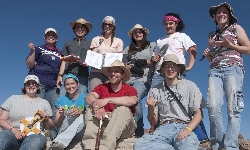
2010 Dinosaur Field Course participants with some "tools of the trade." Front (l-r): Ashley Morhardt, Shannon Barry, Dr. Matt Bonnan, Seth Kunkel. Back (l-r) Hillary Parks, Collin VanBuren, Megan Luczak, Caroline Juarez, Katherine "Kate" Short, Theresa Romando (WIU/VPC photo by Larry Dean)
[Download Print-Quality Image]
MACOMB, IL – Seven college students traded their past sedentary paleontology experiences – most of which had been limited to comfortable theatres, popcorn and movies such as the classic series "Jurassic Park" – and spent 13 days (May 20-June1) learning the hands-on how-to's of excavating and experiencing the excitement of discovering Jurassic Period dinosaur bones from one of the world's most noted paleobiologists.
Matthew Bonnan, an expert on sauropod dinosaurs, is an associate professor of biology at Western Illinois University and a member of the team that, in Nov. 2009, announced to the world the discovery of a new dinosaur in South Africa, named Aardonyx celestae, meaning "earth claw," which he says appears to be closely related to the common ancestor of all sauropods.
A functional morphologist, who understands anatomy and how bones and muscles work together in movement, and a vertebrate paleobiologist, who studies how vertebrate animals have evolved, Bonnan was approached in 2007 by the Burpee Museum of Natural History (Rockford, IL) to join their team digging in the Hanksville-Burpee Dinosaur Quarry (Hanksville, Utah). The quarry is part of the 145-150 million-year-old Jurassic Period Morrison Formation, which is a rock unit composed of sandstones, siltstones and clays laid down by braided rivers in an ancient floodplain, Bonnan explained.
"This was the zenith of gigantism in dinosaurs, the largest of which were the sauropod dinosaurs, some of which exceeded 30 meters (98'4")," Bonnan said.
Scott Williams, director of expeditions, and other members of the Burpee Museum oversee the day-to-day activities at the quarry and worked with Bonnan to prepare future scientific publications on the dig site, including help with the geological survey, mapping in and around the quarry, collecting rock samples, making notes and tracking their position and elevation using GPS.
Bonnan said he is grateful for working with such a committed partner like the Burpee.
"None of this would have been possible without the tireless efforts of the Burpee Museum to find, secure and open the dig site. They do the lion's share of the dig's logistics, they provide us with tools and they are responsible for transporting the precious remains back to their museum," Bonnan added.
In addition to digging, students in Western's dinosaur field course (Zoology 476) learned how to map the excavation site, prepare the bones for excavation and plaster-jacket the bones to keep them from breaking during transportation.
"I don't know if my students fully appreciate this yet, but they are being spoiled rotten. We go right to a dinosaur graveyard with hundreds of bones entombed in rocks that reveal a fantastic story bit by bit as we dig," Bonnan said.
The students for the 2010 dig included, by Illinois county and hometown:
COOK COUNTY
Chicago Ridge (60415) – Katherine "Katy" Short, senior, biology (secondary education) major; and
Melrose Park (60164) – Theresa Romando, sophomore, biology major, functional morphology and evolutionary anatomy minor (FEMA).
DuPAGE COUNTY
Winfield (60190) – Megan Luczak, senior, biology major with a zoology emphasis, anthropology minor; and
Woodridge (60517) – Shannon Barry, junior, biology major with a zoology emphasis, scuba diving minor.
LaSALLE COUNTY
LaSalle (61301) – Collin VanBuren, senior, biology major with a zoology emphasis, functional morphology and evolutionary anatomy minor (FEMA); and
Lostant (61334) – Seth Kunkel, junior, biology major with a zoology emphasis and a forensic science minor.
PEORIA COUNTY
Peoria (61603) – Caroline Juarez, graduate student, biology.
Two Western alumnae from McHenry County, who had been on previous digs to the Hanksville-Burpee site, served as Bonnan's assistants. They are biology student Hillary Parks (Oakwood Hills, IL), a current master's degree student who had earned her Bachelor of Science degree in biology education in Fall 2008; and Ashley Morhardt (Crystal Lake, IL), a Master's of Science in biology alumna (Summer 2009), who is presently working on her doctorate program in Dr. Lawrence Witmer's laboratory at Ohio University. Morhardt also assisted Bonnan in the geological survey of the area in and around the quarry.
Parks was on her third WIU/Burpee dig in Utah and her fourth dig overall. This year she will continue as a master's degree student in Bonnan's laboratory, serve as a biology lab co-coordinator and as a teaching assistant.
"Digging up dinosaurs really has been a childhood dream of mine," Parks added. "After I graduate next spring. I hope to move on to a doctoral program in paleontology so I could work at the college or university level or, perhaps, at a museum."
The dig site was "a jumble of bones in an ancient river system where you don't expect to find anything delicate. Amazingly, Megan Luczak (Winfield, IL) discovered a disarticulated skull from a sauropod dinosaur called Camarasaurus. This dinosaur had kind of a 'boxy' head with a large nose perched atop a long neck," Bonnan said.
"Finding the skull was an awesome experience," Luczak said. "When I began digging, I had no idea what it was; but that seemed to be how every bone started out. As I kept digging, it began to look peculiar, and I knew it was something we had never seen before on this dig. Eventually, Scott Williams (Burpee Museum) came over to check on everyone's progress. When he got to the bone I was digging he did a double take. He brushed some sediment away and proclaimed that I had found a skull! It was a surreal experience. I couldn't believe that I had found something so wonderful and so rare."
"The partially articulated remains of dinosaurs in our quarry are helpful in showing that the animals we are finding died near where they are buried," Bonnan said. "If they had died far away and were transported long distances by the rivers that laid down the sandstones, the bones would instead be few and far between and completely disarticulated."
Vanburen, who I working on an undergraduate Honors thesis about forelimb movement in living mammals and reptiles under Bonnan's guidance, said the field trip was "somewhat of a career changer."
"The field trip rekindled a love for paleontology that I had when I was younger, inspiring me to seek out graduate programs in vertebrate paleontology," he said.
"I remember going into (Bonnan's) office to ask about auditing the dinosaur biology class, which I couldn't fit in to my schedule. After speaking to him about my love for dinosaurs as a child, he asked: 'So, why aren't you becoming a paleontologist'? I had no real answer for him, and the more I thought about it, I was leaning toward going into the field (paleontology). The dig made that last push for me, and now paleo is what my heart is set on," Vanburen added.
Bonnan and WIU students first visited the Hanksville-Burpee site in 2008.
"I was blown away by the sheer numbers of bones and the great preservation. The site occurs during the hay day of really big sauropods of the late Jurassic period, about 145-150 million years ago," Bonnan said.
Since 2008, the Burpee Museum, WIU and the Utah Bureau of Land Management have coordinated digging at the Hanksville-Burpee Dinosaur Quarry each year.
"Probably the most important thing about this dinosaur find is the potential for cooperation and mutual benefit to scientists, the public and especially the people of Hanksville, Utah," said Bonnan. "The Hanksville-Burpee site and all of its contents were found on public land and so belong to everyone.
"Dinosaurs are an excellent vehicle for science education and outreach. Already a diverse group of scientists, students and volunteers from Western Illinois University, the Burpee Museum and the Utah Bureau of Land Management have participated in preserving this natural treasure," Bonnan added. "As a dinosaur paleontologist, I am simply happy to help uncover our shared, ancient past and hope that, in the process, we all benefit."
Read Bonnan's Jurassic Journeys blog at http://jurassicjourneys.net, his biology homepage at wiu.edu/biology/faculty/bonnan.php and information on the new dinosaur "Aardonyx" celestae (Earth Claw) he co-discovered at wiu.edu/EarthClaw.
"Any university student wishing to be 'schooled' in all things dinosaur should register for the WIU dinosaur field course next summer, 2011. You will not regret it," Bonnan said.
The field course will be offered through Western's Study Abroad next summer, and interested students can find out more from Bonnan at the 10 a.m.-3 p.m. Wednesday, Sept. 1 Study Abroad Fair on the University Union Plaza, outside the north doors by Hanson Field (football stadium).
Posted By: University Communications (U-Communications@wiu.edu)
Office of University Communications & Marketing

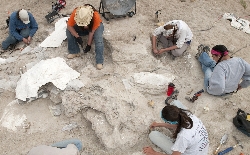
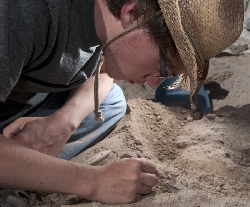
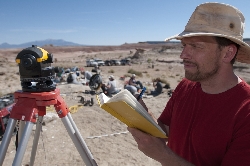
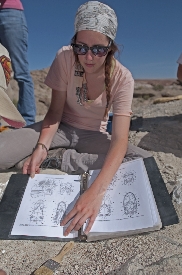
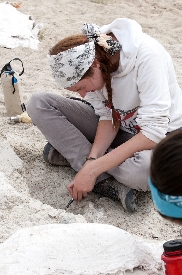
Connect with us: